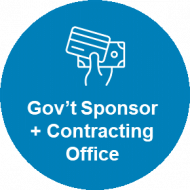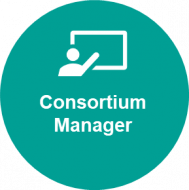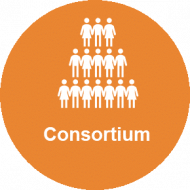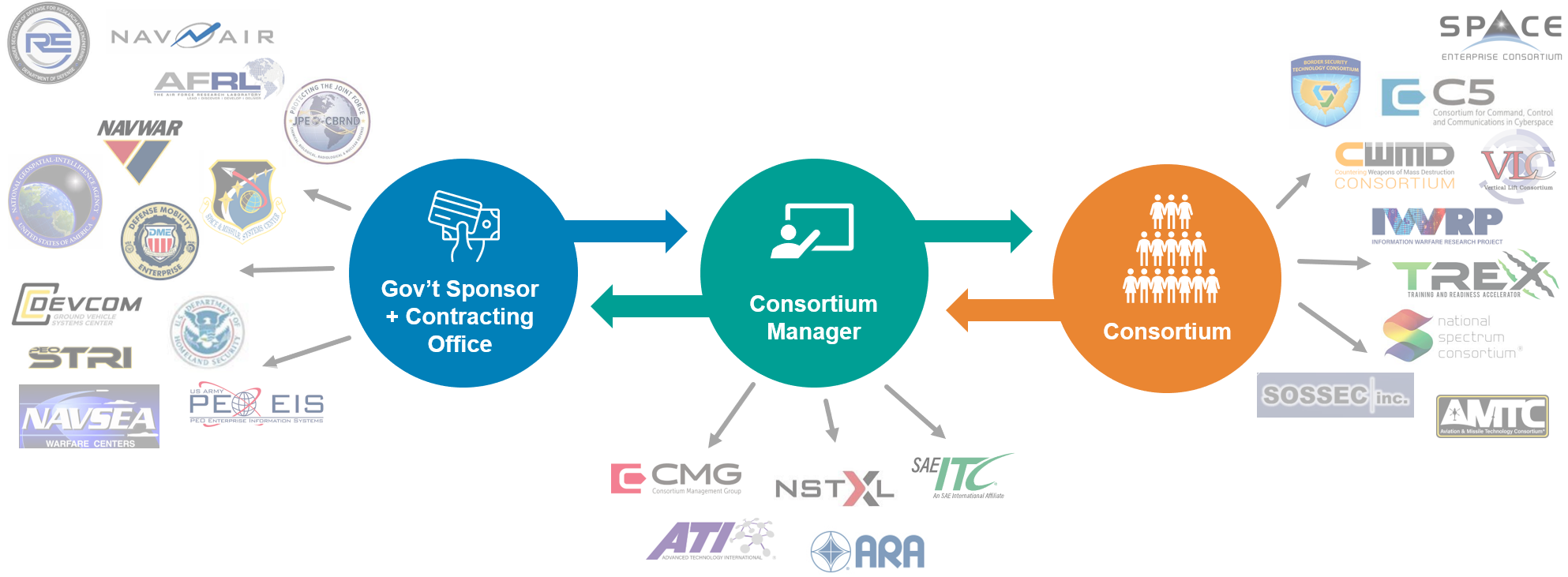Other Transaction Authority (OTA)
What is an “Other Transaction”
 Other Transactions (OTs) are procurement instruments other than contracts, grants, or cooperative agreements enabling flexible business arrangements generally used to acquire research and development, support technology advancement, or develop a prototype. Federal agencies have varying statutory authorizations for OT uses, limitation, and restrictions. See Agencies Authorized to Use OTs below for details.
Other Transactions (OTs) are procurement instruments other than contracts, grants, or cooperative agreements enabling flexible business arrangements generally used to acquire research and development, support technology advancement, or develop a prototype. Federal agencies have varying statutory authorizations for OT uses, limitation, and restrictions. See Agencies Authorized to Use OTs below for details.
Many laws and regulations governing federal contracts do not apply to OTs (e.g., Federal Acquisition Regulation (FAR) an agency supplements, Competition in Contracting Act (CICA), Cost Accounting Standards (CAS), Truth in Negotiations Act (TINA)), however, the Procurement Integrity Act applies and competitive practices are applicable to the maximum extend practicable. OTs are not subject to the procurement protest process (FAR Part 33), but may be protested to the U.S. Court of Federal Claims. GAO has limited jurisdiction to review OT decisions.
OTs are a mechanism to access innovative solutions, especially from *non-traditional contractors who may be challenged by requirements of traditional contracts, grants, or cooperative research and development agreements. OTs can be used with traditional contractors when applicable statutory requirements are met. OTs allow for flexibility to negotiate terms and conditions beyond what is permitted under statutes and regulations that apply to FAR-based contracts. OT agreements may be fixed-price, expenditure-based, or hybrid.
*32 CFR §3.4 defines a non-traditional defense contractor as a business unit that has not, for a period of at least one year prior to the date of the OT agreement, entered into or performed on (1) any contract that is subject to full coverage under the cost accounting standards prescribed pursuant to section 26 of the Office of Federal Procurement Policy Act (41 U.S.C. 422) and the regulations implementing such section; or (2) any other contract in excess of $500,000 to carry out prototype projects or to perform basic, applied, or advanced research projects for a Federal agency, that is subject to the Federal Acquisition Regulation.
The Secretary of Defense signed the Directing Modern Software Acquisition to Maximize Lethality memorandum on 6 March 2025 directing the use of Commercial Solutions Openings and Other Transactions as the default
solicitation and award approaches for acquiring capabilities under the Software Acquisition Pathway.
Two types of Other Transaction Authority are available to the Department of Defense (DoD). The USD A&S Other Transactions Guide (v2.0 Jul 2023) provides conditions for use as well as guidance for planning and executing Research and Prototype OTs as well as follow-on Production OTs.
Research OTs – 10 U.S.C. §4021 are applicable for basic, applied, and advanced research projects to pursue development and application of dual-use technology. Unlike Prototype OTs, Research OTs do not include authority for transition to follow-on production contracts or transactions. Research OTs require cost sharing arrangements between the government and the other party/parties, typically split 50/50, although the ratio is negotiable based on resources, previous technological investments, commercial vs. government applicability, performance risk, and nature of a project. Although the Competition in Contracting Act (CICA) is not applicable, competition should be pursued to the maximum extent practicable to incentivize high quality and competitive pricing.
Prototype OTs – 10 U.S.C. §4022 are appropriate for research and development and prototyping activities to enhance mission effectiveness of military personnel and supporting platforms, systems, components, or materials. Prototype OTs may only be used to develop limited quantities of prototypes, however, they can provide a path to directly award a follow-on Production OT or contract without having to re-compete the effort. This is an important benefit of the Prototype OT approach, but programs must develop acquisition approaches for prototype projects that address anticipated follow-on activities to properly take advantage of this authorization and also ensure the organization is prepared and resourced to move forward with a successful prototype OT.
Prototype Project Definition
A prototype project addressing a proof of concept, model, reverse engineering to address obsolescence, pilot, novel application of commercial technologies for defense purposes, agile development activity, creation, design, development, demonstration of technical or operational utility, or combinations of the foregoing. A process, including a business process, may be the subject of a prototype project.
Source: USD A&S and USD R&E Memorandum, Definitions and Requirements for Other Transactions Under Title 10, United States Code, Section 2371b
Using Prototype OT Authority
One of the following conditions must be met to award a Prototype OT (Source: USD A&S and USD R&E Memorandum, Definitions and Requirements for Other Transactions Under Title 10, United States Code, Section 2371b):
- At least one non-traditional defense contractor participates to significant extent or
- All significant participants are small or non-traditional defense contractors or
- One third of total cost provided by sources other than gov (if no non-traditional defense contractor participation) or
- The Agency Senior Procurement Executive determines circumstances justify use of a transaction that provides for:
- Innovative business arrangements not feasible or appropriate under a contract
- Opportunity to expand defense supply base not practical or feasible under a contract
Conditions for Follow-on Production OT or Contract (Source: USD A&S and USD R&E Memorandum, Definitions and Requirements for Other Transactions Under Title 10, United States Code, Section 2371b)
Prototype OTs must specifically state the possibility for a follow-on production OT or contract in both the Prototype OT solicitation and the Prototype OT agreement. Non-competitive follow-on awards are limited to the participants in the OT prototype project and the following criteria must be satisfied:
- Competitive procedures were used to select the parties to participate in the prototype project; and
- Participants in the transaction successfully completed the prototype project provided for in the transaction
Prototype OTs must include defined conditions for the prototype agreement to be determined successfully completed and thereby eligible for a follow-on production award. Successful completion of a prototype project requires written determination by the responsible approving official stating the efforts under a Prototype OT satisfy the following criteria
- Met the key technical goals of a project;
- Satisfied success metrics incorporated into the Prototype OT; or
- Accomplished a particularly favorable or unexpected result that justifies the transition to production
OT Approvals and Thresholds
Approvals and Thresholds (Source: USD A&S Memorandum Authority for Use of Other Transactions for Prototype Projects Under 10, United States Code, Section 4022)
Approval authorities and thresholds for Prototype Project OT Awards:
| Value of Individual Transaction | |||
| Organization | Up to $100M | $100M to $500M | Over $500M |
| Combatant Commands (CCMDs) with contracting authority | Head of Contracting Activity (HCA) | Senior Procurement Executive (SPE) | USD(R&E) or USD(A&S) |
| Defense Agencies and Field Activities with contracting authority | HCA | SPE | USD(R&E) or USD(A&S) |
| Military Departments | HCA | HCA | SPE |
| DARPA, DIU, and MDA | HCA | Director | Director |
- As a matter of policy, approval of a follow-on production OT agreement or contract valued in excess of $100 million requires prior coordination with the appropriate Under Secretary.
- The authority of the head of the contracting activity, directors of DARPA, DIU, MDA, or the SPE, as applicable may not be delegated pursuant to section 4022(a)(3).
Approval authorities and thresholds for follow-on Production Contracts and OT Agreements:
| Value of Individual Transaction | |||
| Organization | Up to $100M | $100M to $500M | Over $500M |
| Combatant Commands (CCMDs) with contracting authority | Commanding Officer | USD(R&E) or USD(A&S) |
USD(R&E) or USD(A&S) |
| Defense Agencies and Field Activities with contracting authority | Director | USD(R&E) or USD(A&S) |
USD(R&E) or USD(A&S) |
| Military Departments | Service Acquisition Executive (SAE) | SAE | SAE |
| DARPA, DIU, and MDA | Director | Director | Director |
- As indicated in section 4022 for all threshold levels, the value shall include all options.
- In determining the value of a given transaction for the purposes of assessing compliance with the authority levels set forth above, OT agreements will be measured based on the value of each transaction, rather than the total value of all OT agreements that might be executed in a prototype project or for follow-on production. That is, a prototype project may consist of multiple transactions to the same or different parties, each of which shall be considered separately when considering dollar thresholds.
- Transaction value shall include all options with prices established in the OT agreement as awarded as well as the amount associated with any cost-sharing borne by the performer where the basis for the OT is subsection 4022(d)(1)(C).
- Regardless of value, a separate OT approval will be required for each phase-prototype or follow-on production-and separately within a phase for each transaction.
Required and Recommended Use of eBusiness Tools for OTs
REQUIRED:
Federal Procurement Data System (FPDS)
- Report each OT for Prototypes or Follow-on Production new award and any subsequent modifications in the Other Transaction module in FPDS within three (3) business days of the action being awarded.
- Report each Other Transaction for Research and any subsequent amendments in the FAADC module in FPDS within three (3) business days of the action being awarded.
- Report each Procurement for Experimental Purpose following the policies for the type of award being issued as described above.
System for Award Management (SAM) Entity Information/Reporting
- Include terms in the OT award that require the awardee to maintain an active registration for ‘All Awards’ in SAM throughout the life of the OT award. Components are encouraged to use a term substantially the same as the one found at FAR Clause 52.204-7.
- Before modifying the OT award to extend its period of performance (including prenegotiated options to extend), confirm that the OT awardee has an active SAM registration for All Awards.
- Include terms in the OT award to a Consortium that requires all of its member organizations to obtain and maintain UEIs for the purposes of statutory reporting requirements.
- Report the UEI of consortium members performing on individual orders under OT agreements in the FPDS OT module.
Government-Furnished Property (GFP) Module
- Include terms in the Other Transaction award, when government property will be provided (as described above) that require the Other Transaction awardee to use the GFP Module in PIEE to report the following transactions when they occur:
a. Receipt of GFP
b. Property loss
c. Plant clearance
Components are encouraged to use a term(s) substantially the same as those found at FAR Clause 52.245-1 and Defense FAR Supplement (DFARS) Clauses 252.245-7001 through -7004 and 252.211-7007. - Create and approve GFP Attachments within the GFP Module.
- Use the GFP Module for tracking shipping of GFP.
- Include in the OT awards the requirement for and instructions on how to use WAWF. Components are encouraged to use a term(s) substantially the same as those found at DFARS 252.232-7003 and 252.232-7006.
- Ensure that the language of the OT designates which activity is going to perform the acceptance and approval processes. Individuals performing these roles within that activity must establish a WAWF account with the appropriate role(s) for receipt,
acceptance, and payment of invoices. - Use WAWF for receiving and approving payment requests and for collecting and accepting evidence of performance except for classified transactions and when a purchase card is being used for payment.
Electronic Data Access
- Ensure the agreement and all modifications are posted to EDA. This is sufficient to ensure the required distribution to payment office and contract administration offices.
- Establish a PIEE account with the appropriate role(s) for PCM Purpose Code Manager. This can be done centrally or can be distributed.
- Ensure that the DoDAACs that are involved with issuing, administering, or paying the Other Transaction Agreement have the appropriate flags set in PCM.
RECOMMENDED:
System for Award Management Contract Opportunities
- While FAR Part 5 requiring use of SAM for posting opportunity notices does not apply to OTs, it is recommended as a best practice for AOs to include a Contract Opportunities posting as a means to reach the maximum number of vendors in addition to other market research methods used.
- If a solicitation for a requirement, such as a broad agency announcement (BAA), could result in either an OT or FAR-based contract, then SAM Contract Opportunities should be used in addition to other solicitation mechanisms.
AVAILABLE:
- The Solicitation Portal is not required by policy. However, it does provide a centralized location for sharing solicitations with industry and receiving proposals using standard data.
Direct OT Awards
Agencies with Other Transaction authority and Agreement Officers can execute OTs, but must establish processes to solicit, evaluate, negotiate, and award OT agreements. It is not advised to leverage FAR processes to execute OTs. There is not a single established process for executing OTs. Projects or programs seeking to use OTs may leverage white papers, demonstrations, competitive prototyping, phased down-selects, or any combination thereof to construct a strategy to achieve objectives.
For further guidance about planning and executing OT agreements, refer to agency specific OT guidance and training, as well as resources below.
OT Consortia
An OT Consortium is a relationship between a government sponsor and a collection of traditional and non-traditional vendors, non-profit organizations, and academia aligned to a technology domain area (i.e., cyber, space, undersea, propulsion) that are managed by a single entity, and focused on innovative solutions to government technology challenges that meet the intended scope and purpose of other transactions.
OT Consortium Model
OT Consortia generally have 3 components, although some government sponsors opt to manage a consortium in-house rather than hire an industry Consortium Manager or Consortium Management Firm. The Consortium Manager is awarded an OT agreement by the government (base OT agreement) and manages OTs awarded to its consortium member organizations (project OT agreements) under the base agreement.


| Consortium Sponsor (Government Sponsor and Contracting Office) |
| Awards Other Transaction agreement to a Consortium Manager to execute administrative processes and workload (base OT agreement) for a specific technology domain area |
| Establishes consortium objectives and overarching guidelines to execute the consortium |
| Selects projects to be awarded to the consortium based on compatibility with consortium objectives and appropriateness of project for an OT award |
| Approves evaluation selection criteria and project OT award selection/s |

| Consortium Manager (specifics will vary among consortia) |
| Establishes processes for consortium application, membership terms, collects membership fees/dues* |
| Executes consortium member agreements with each member organization |
| Collects a % of fee for each project OT awarded under the base OT agreement* |
| In collaboration with the government sponsor, supports government customers to: develop problem statements, requests for white papers, requests for prototype proposals (RFPPs), determine whether demos will be requested, develop phased selection processes, develop criteria to evaluate proposals, etc. |
| Communicates requests for white papers/RFPPs to consortium members, usually via internal website or portal (some announcements may be public, but the details are usually available only to consortium members) |
| Facilitates demos and other communication between consortium members and government customer; support demo evaluation and determinations to advance to next phase of selection process |
| Manages proposal evaluations and project OT agreement award selection/s, negotiations, and cost analysis (gov sponsor ultimately approves) |
| Manages post project OT agreement award administrative activities on behalf of government customer such as monitoring deliverables, invoice/payment tracking, and reporting (gov customer is responsible for day to day activities with contractor/s) |
| Maintains “library” of proposals not selected/not funded for potential future use for current gov customer or new gov customer |
| *membership fees/dues and % of fee for award vary among consortia. See Existing OT Consortia page for individual consortium information. |

| The Consortium |
| A consortium is established to support a specific technology domain area (i.e., cyber, space, undersea, propulsion) |
| Consortium membership is open to qualifying US entities (varies by consortium): |
| – Traditional/non-traditional contractors |
| – Non-profit organizations |
| – Academic institutions |
| Some consortia open to foreign entities |
| Qualifying entities may join one or multiple consortia |
| Consortium members are subject to terms of membership, which may include an annual membership fee and a fixed-percentage fee applied to each project OT agreement awarded |
| Members typically have access to requests for white papers, requests for prototype proposals(RFPPs), etc. from government customers specific to the consortium |
| Some consortia managers may facilitate partnering opportunities among members |
| Members may be able to partner with other members to propose solutions |
| Traditional contractors must be prepared to meet cost-sharing requirements of other transaction authorities |
| Members may negotiate unique terms and conditions for individual projects |
| Members that receive project OT awards will be assessed a % of fee by the consortium manager in accordance with consortium terms and conditions |
Pros and Cons of Consortia
| Pros | Cons |
| A pool of vendors aligned to consortium focus area (i.e., cyber, space, undersea, propulsion) promotes an environment for collaboration with the government and with other consortium members. | Non-traditional vendors, non-profit organizations, and academic organizations may be challenged by the financial considerations of consortia membership due to fees and % of award fees charged by consortia. |
| Consortia execute OT agreements which allow for a more collaborative process than traditional FAR processes that are bound by rigid source selection statutes and regulations. | Some consortia are in high demand by government customers and are thereby resource constrained. This can due to volume of work for the consortium or by the availability of the assigned government contracting office. |
| Consortia have established streamlined processes that quickly move through white papers, demos, proposals, evaluations, and selections and often execute awards more quickly than traditional government acquisition programs. | Many consortia do not award follow-on production activities. |
Sample organizations in each component of the OT Consortium Model
for illustrative purposes only | all organizations not represented

Questions to Ask when Shaping an OT Strategy
- Does the agency currently have Congressional authorization for OTs?
- Will the organization’s approval authorities grant permission to use an OT? What additional information is necessary to gain their approval?
- How will the funding arrangements work (timing, amounts, color of money, etc.)? When are funds available?
- Does the organization have experience with OTs and a warranted Agreements Officer?
Resources
- COFC No. 24-1824C, Determine the Scope of COFC Jurisdictional Authority to Adjudicate Bid Protests Involving “Other Transactions”, Feb 2025
- Court of Federal Claims Asserts More Jurisdiction over OTAs, Federal News Network, Jul 2024
- COFC No. 24-160, Independent Rough Terrain Center, LLC (“IRTC”) Challenges Scope of Corrective Action for Follow-On Production Contract Solicitation, Jul 2024
- GAO Decision B-333150, Health and Human Services—Application of Fiscal Law to Other Transactions, Apr 2024
- GAO-24-106746 U.S. Army Corps of Engineers: Use of Other Transaction Agreements in Water Development Projects, Nov 2023
- Report to Congress On the Use of Other Transaction Authority for Prototype Projects In FY 2022, OUSD A&S, Apr 2023
- OIG-23-601 Summary of Federal OIG Findings and Recommendations Related to Other Transaction Agreements, NSF OIG, Mar 2023
- Other Transaction Agreements: DOD Can Improve Planning for Consortia Awards, GAO, Sep 2022
- Audit of DoD Other Transactions and the Use of Nontraditional Contractors and Resource Sharing, DoD IG, Sep 2022
- The Power of Many: Leveraging Consortia to Promote Innovation, Expand the Defense Industrial Base, and Accelerate Acquisition, GMU Center for Government Contracting, Jul 2022
- Audit of Other Transactions Awarded to Consortiums, DoD IG, Apr 2021
- Other Transaction Authority and the Consortia-based Acquisition Model: A Valuable Tool for Rapid Defense Innovation, The Chertoff Group, Jan 2021
- DOD’s Use of Other Transactions for Prototype Projects Has Increased, GAO, Nov 2019
- GAO Decision B-416752, Blade Strategies, LLC Protest of Army’s Use of OTA, GAO, September 2018
- GAO Decision B-416061, Oracle America Inc., Protest of Production OTA to REAN Cloud LLC, GAO, May 2018
- The Federal Government’s “Other Transaction” Authority, Westlaw, Apr 2018
- DoD Use of OTA: Background, Analysis, and Issues for Congress, CRS, Feb 2018
- GAO-18-172 Transportation Security Administration: After Oversight Lapses, Compliance with Policy Governing Special Authority Has Been Strengthened, Dec 2017
- OIG-18-24 Department of Homeland Security’s Use of Other Transaction Authority, Nov 2017
- Use of Other Transaction Agreements (OTAs) Limited and Mostly for R&D Activities GAO, Jan 2016
- DARPA OT Training, Feb 2025
- CCON 023 Other Transaction Authority (OTA) Credential, DAU, Mar 2024
- ARPA-H OT Training
- Non-traditional Defense Contractor Status Validation Guide – SAM.gov, DAU
- Evaluating Price; Other Transactions (OTs) v6, DCMA Commercial Item Pricing Group
- Pricing Other Transactions: Striking the Balance Between Speed and Price (video), DAU/DCMA, Jan 2021
- OTA Best Practices for Industry and Government, ACT-IAC, Jul 2020
